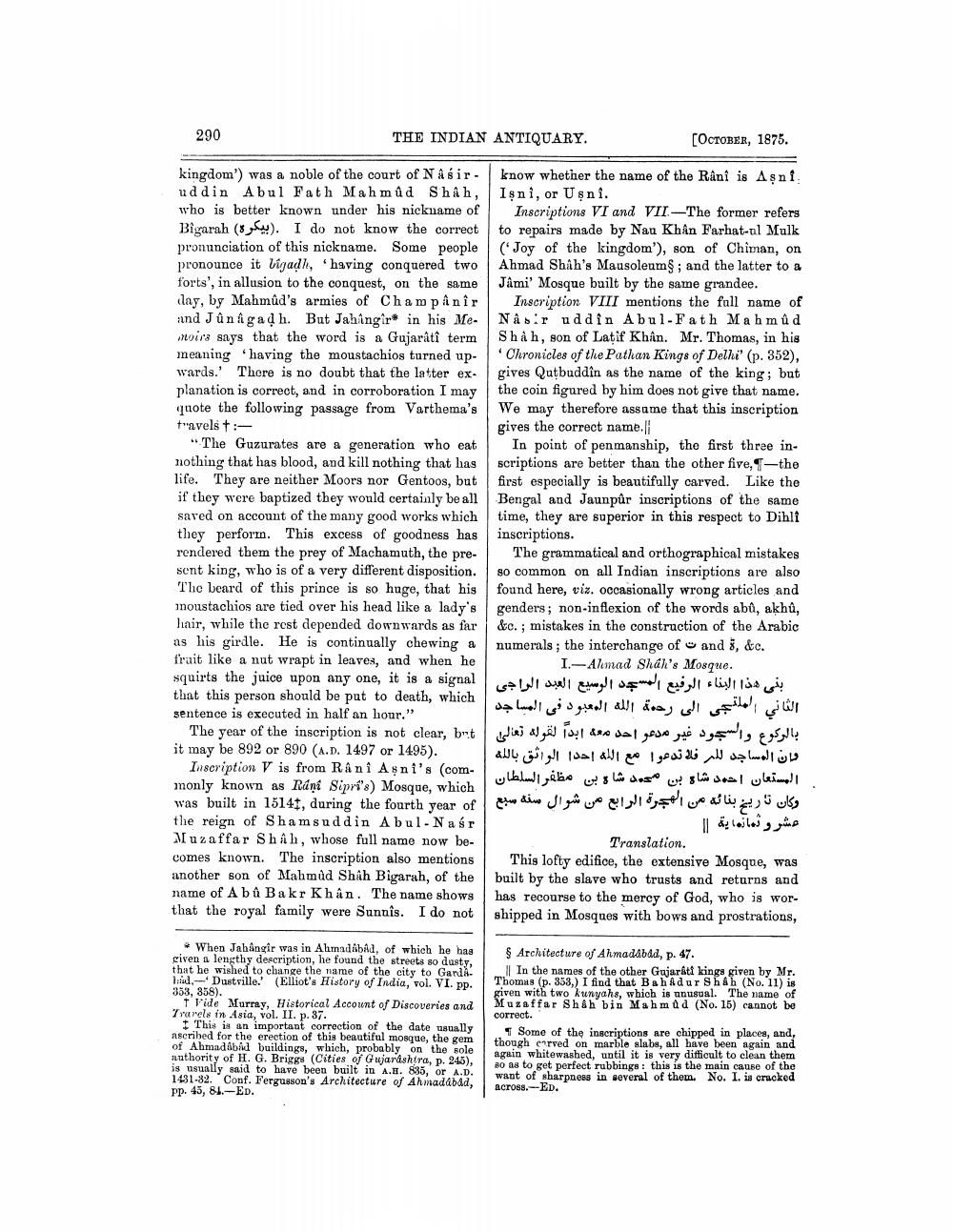________________
290
THE INDIAN ANTIQUARY.
kingdom') was a noble of the court of Nâ siruddin Abul Fath Mahmûd Shah, who is better known under his nickname of Bigarah (8). I do not know the correct pronunciation of this nickname. Some people pronounce it bigadh, having conquered two forts', in allusion to the conquest, on the same day, by Mahmûd's armies of Champânîr and Junagadh. But Jahangir in his Memoirs says that the word is a Gujarâtî term meaning 'having the moustachios turned upwards.' There is no doubt that the latter explanation is correct, and in corroboration I may quote the following passage from Varthema's +"avels + :
"The Guzurates are a generation who eat nothing that has blood, and kill nothing that has life. They are neither Moors nor Gentoos, but if they were baptized they would certainly be all saved on account of the many good works which they perform. This excess of goodness has rendered them the prey of Machamuth, the present king, who is of a very different disposition. The beard of this prince is so huge, that his moustachios are tied over his head like a lady's hair, while the rest depended downwards as far as his girdle. He is continually chewing a fruit like a nut wrapt in leaves, and when he
that this person should be put to death, which sentence is executed in half an hour."
بني هذا البناء الرفيع المسجد الوسيع العبد الراجي | squirts the juice upon any one, it is a signal
الثاني العلاجى الى رحمة الله المعبود في المساجد بالركوع والسجود غير مدعو احد معه ابداً لقوله تعالى | The year of the inscription is not clear, bt
دان المساجد لله فلا تدعوا مع الله احدا الواثق بالله المستعان احمد شاه بن محمد شاه بن مظفر السلطان وكان تاريخ بنائه من الهجرة الرابع من شوال سنة سبع عشر و ثمانية ||
it may be 892 or 890 (A.D. 1497 or 1495).
Inscription V is from Râni Aṣni's (commonly known as Ráni Sipri's) Mosque, which was built in 15141, during the fourth year of the reign of Shamsuddin Abul-Nasr Muzaffar Shah, whose full name now becomes known. The inscription also mentions another son of Mahmûd Shâh Bigarah, of the name of Abu Bakr Khân. The name shows that the royal family were Sunnis. I do not
When Jahangir was in Ahmadâbâd, of which he has given a lengthy description, he found the streets so dusty, that he wished to change the name of the city to Garda. hid, Dustville.' (Elliot's History of India, vol. VI. pp. 353, 358).
[OCTOBER, 1875.
know whether the name of the Rânî is Asni Isni, or Usni.
Inscriptions VI and VII-The former refers to repairs made by Nau Khân Farhat-ul Mulk (Joy of the kingdom'), son of Chiman, on Ahmad Shah's Mausoleum§; and the latter to a Jami' Mosque built by the same grandee.
Inscription VIII mentions the full name of Nâ sir uddin Abul-Fath Mahmûd Shah, son of Latif Khân. Mr. Thomas, in his 'Chronicles of the Pathan Kings of Delhi' (p. 352), gives Qutbuddîn as the name of the king; but the coin figured by him does not give that name. We may therefore assume that this inscription gives the correct name.||
In point of penmanship, the first three inscriptions are better than the other five, T-the first especially is beautifully carved. Like the Bengal and Jaunpûr inscriptions of the same time, they are superior in this respect to Dihli inscriptions.
Tide Murray, Historical Account of Discoveries and Travels in Asia, vol. II. p. 37.
This is an important correction of the date usually ascribed for the erection of this beautiful mosque, the gem of Ahmadabad buildings, which, probably on the sole authority of H. G. Briggs (Cities of Gujarashtra, p. 245), is usually said to have been built in A.H. 835, or A.D. 1431-82. Conf. Fergusson's Architecture of Ahmadabad, pp. 45, 81.-ED.
The grammatical and orthographical mistakes so common on all Indian inscriptions are also found here, viz. occasionally wrong articles and genders; non-inflexion of the words abû, akhû, &c. ; mistakes in the construction of the Arabic numerals; the interchange of and 3, &c. I-Ahmad Shah's Mosque.
Translation.
This lofty edifice, the extensive Mosque, was built by the slave who trusts and returns and has recourse to the mercy of God, who is worshipped in Mosques with bows and prostrations,
§ Architecture of Ahmadabad, p. 47.
In the names of the other Gujarati kings given by Mr. Thomas (p. 353,) I find that Bahadur Shah (No. 11) is given with two kunyahs, which is unusual. The name of Muzaffar Shah bin Mahmûd (No. 15) cannot be
correct.
Some of the inscriptions are chipped in places, and, though carved on marble slabs, all have been again and again whitewashed, until it is very difficult to clean them so as to get perfect rubbings: this is the main cause of the want of sharpness in several of them. No. I. is cracked across.-ED.




